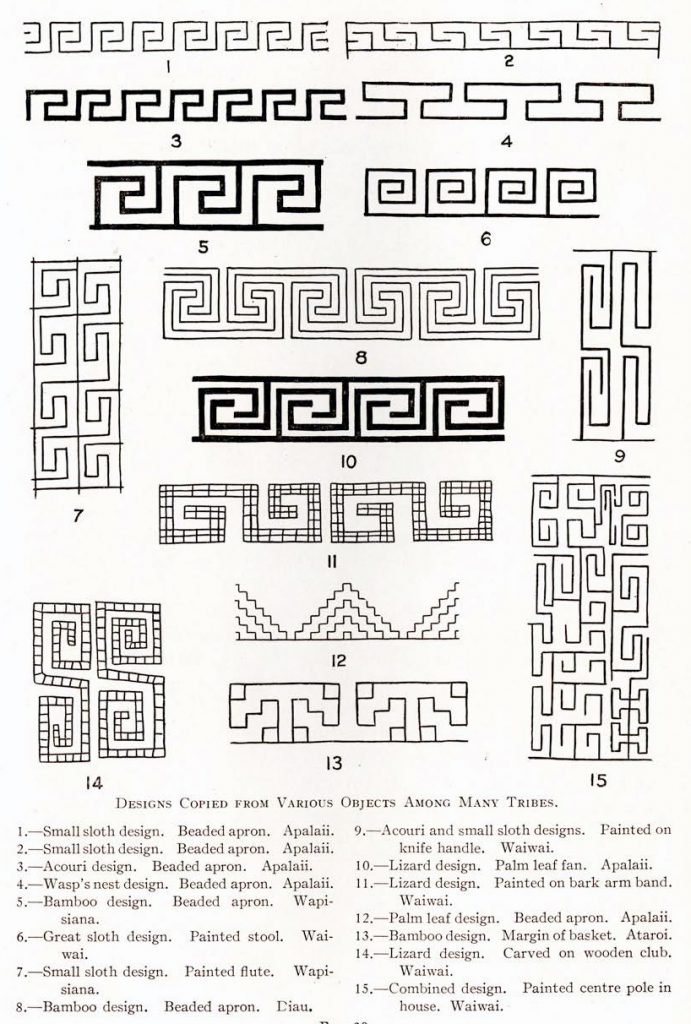In common use the term “art” is confined to the designation of the Fine Arts and is limited in its application to sculpture and painting. In this sense there is no art among primitive peoples, for their arts are instinctive in the beginning and confined in their use to decorative purposes. The human body and objects with which man had to deal, such as implements and utensils, are made more attractive by embellishment. The body is adorned by the attachment of extraneous objects in the form of necklaces, ear, nose or lip ornaments, or by the application of paint in monochrome or in designs. Where the decoration is desired to remain in a more permanent form, scarification and tattooing are employed. Weapons and implements are rendered more pleasing by the application of incised or painted designs. Among primitive people generally, the decorative designs do not serve purely æsthetic purposes, but are used more particularly for the expression of an idea.
For several years there has been much discussion concerning the origin of designs and the development of the arts. The opinion prevailed for a time that all designs had their origin in realistic forms and that these forms became more and more conventionalized, due to material, the limits of technique and the transfer of designs developed in one technique to another, such as that from textiles to pottery, from wood to stone or from painted to incised designs.
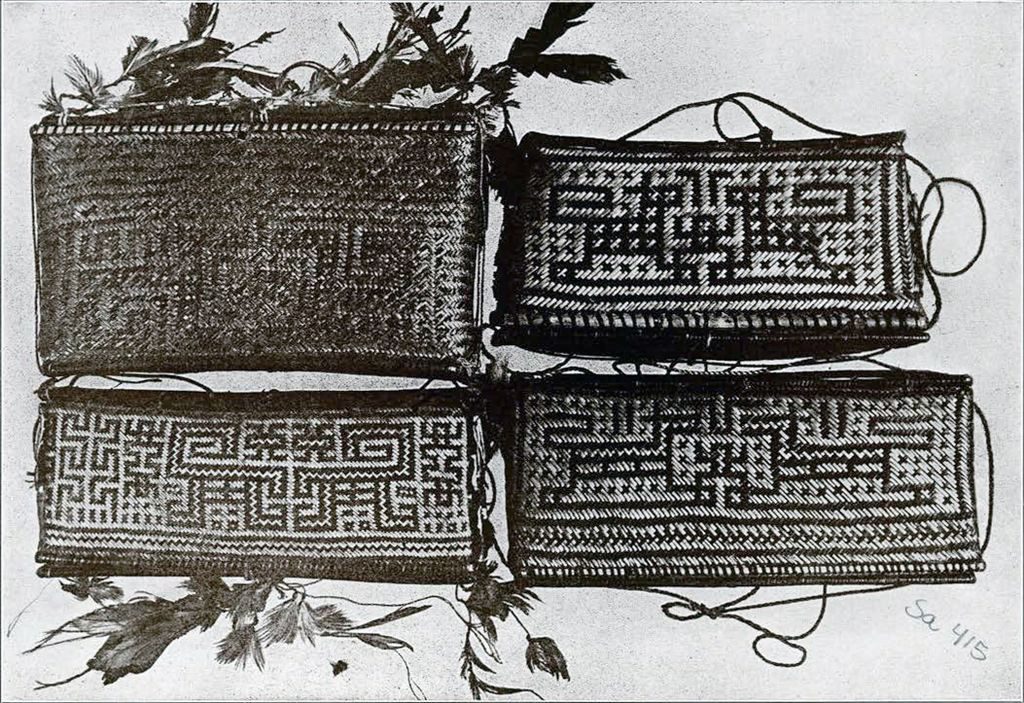
Museum Object Numbers, From Top Left: SA806 / SA443 / SA415
Image Number: 20806
More recently attempts have been made to show that the explanation of the design is secondary and that the transition from realism to conventionalism, from natural to geometric forms did not take place, but that in the early stages of the historic development both textiles and pottery were decorated with geometric designs, while realistic figures came into use much later as an explanation of the design. In other words, that the origin of art must be found in the simple geometric designs imposed upon the worker by textile technique while the realistic explanations were later read into these designs. It is pointed out that unrelated tribes interpret the same design by different ideas and that the same idea is expressed by them in distinctly different designs.
All students of primitive art agree that designs are considered significant today and that savages everywhere attempt to explain them. The questions which naturally arise are—why are they significant now if they were not so in the beginning? When and how would the savage attach importance to them? Again, how could the technique force designs upon the worker? It does not do so today with civilized man. Neither does the modern artist invent his designs outright. He studies the art of other times and other peoples in search for suitable motives and ideas which he may modify, combine and recombine into new forms. Primitive man got his ideas and took his designs direct from nature and, as we shall attempt to show, he found an abundance of material. We shall show how particular geometric designs had a natural growth from realistic reproductions of particular objects. These designs are so simple that similar ones in other regions may have had different origins, hence it might be expected that different ideas would be expressed by the same designs, and vice versa.
Decorative art is so directly conditioned by its environment that one must know all the elements of climatic, physical and social conditions before he can begin to understand or to appreciate the art. He must know the conditions of life with reference to food supply, the tools and materials with which the artist had to work and the inspiration received from political and religious organizations.

Image Number: 20781

Museum Object Number: SA108
Image Number: 20778
For the development of art a certain amount of leisure is required. An abundance of regular food for daily consumption or abundant harvests with storage facilities guarantees a leisure from day to day or from season to season which may be anticipated and improved. Not only leisure but energy is required for application. Where there is a constant struggle for existence or where there is a debilitating climate art cannot develop to a high degree of perfection. If the region does not contain suitable materials for the artist to work upon or convenient tools to work with he is handicapped at the beginning. If the groups of people are isolated for any cause and seldom come into friendly competition, little interest can develop in any line of endeavour. And again, if there is no highly organized ritualistic religion, art lacks by far its greatest inspiration. From these considerations it may be stated that artistic skill depends largely upon the favorableness of the material at hand and that the art of any region more correctly reflects the character of the environment than the character of the people.
The conditions of life among the inhabitants of the Amazon valley are easy because there is a readily secured and constant food supply. There is no necessity for storing or preserving food against a future need, as it may be had any day at any time of year. Thus there is no season for labor nor regular periods of leisure. The climate is debilitating and the little energy possessed is expended in supplying the daily bread. Thus the two first essentials for the development of the arts, leisure and energy, are wanting. There are lacking also suitable materials for the development of the arts. There are no rocks for graving, flints for chipping nor metals of any kind for the manufacture of tools or ornaments. The climate does not require clothing of tanned skins or woven fabrics which might be decorated. Rude shelters serve for all the protection needed against the elements. Thus there can be no architecture. The attachment of unnecessary projections, mouldings, cornices, carvings, frescoes, etc., can not be applied to houses of leaves. Sculpture probably developed from the shaping of stone implements, fetishes, etc., but here there are no stones.
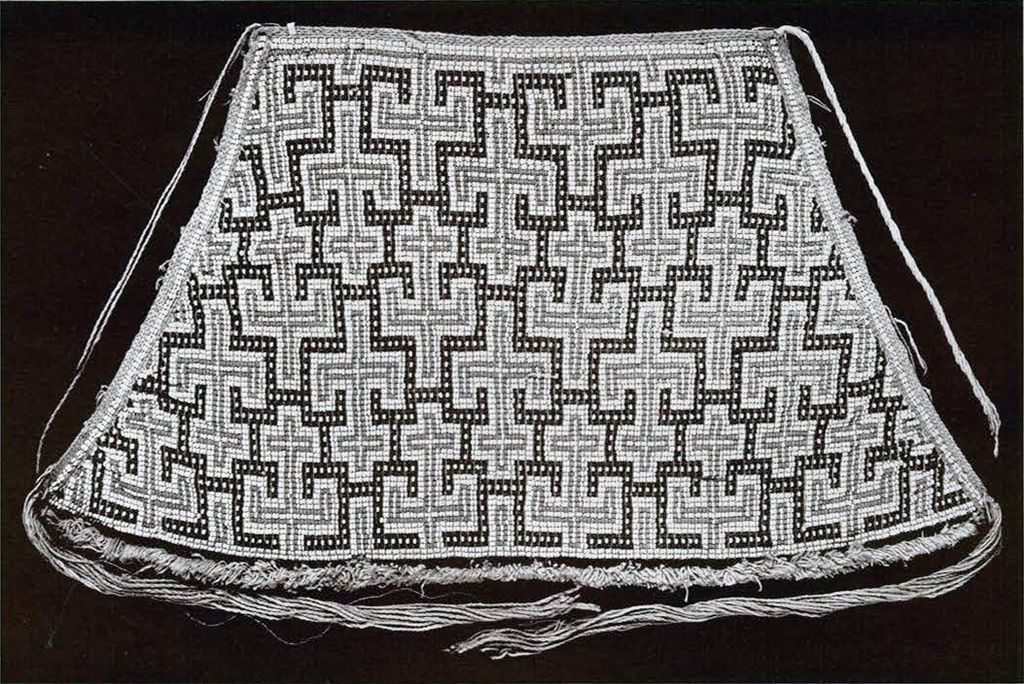
Museum Object Number: SA218
Image Number: 20782
The people live in small isolated groups which wander about at will without coming into stimulating contact with other groups. They have no amulets, charms nor fetishes; neither animal, ancestor nor hero worship. There are no high mountains, volcanoes nor earthquakes; no droughts, famines nor epidemics. Nothing to excite wonder or admiration; and no necessity for intercessions nor reasons for thanksgiving. Their religion is simple. It requires a creator in order to account for every-thing in nature, but it has no place for the worship of a Great Spirit because he is not needed in the daily life of the people.
Here we have art in its very beginning as applied to the person for embellishment and to the few objects in daily use for ornament. In this stage it has hardly passed beyond the physical aspect in which pleasureable sensations are produced by the harmony of lines and spots of color. The people decorate their bodies with color and ornaments without special significance. Their well made pottery is undecorated except in monochrome. Weaving is done only in making plain breech cloths for the men. Basketry alone of all the utilitarian arts is being developed and considerable skill has been attained. Probably the checker pattern naturally produced by the technique suggested the idea of inserting designs into the weaving. Animate objects were introduced not so much for beauty as for increasing pleasureable sensations. The relation between warp and woof rendered it impossible to make curved lines or diagonals except in step patterns. All figures were thus compelled to assume rectangular forms and it was impossible for the worker to reproduce realistic objects true to nature. Any characteristic of the animal or plant must be exaggerated to insure the proper interpretation. Often some particular part of the body or peculiar color form was used to represent the object. When these realistic forms were repeated and made to cover the whole surface it often happened that the border was made up of one half of the object. This, no doubt, gave the idea of using this part only to represent the object and to repeat it as a margin when there was a desire to have a plain central portion. When space relations required it these characteristic parts were used to complete a decoration. Thus the design came to be used as a symbol. It will be seen that these designs, Fig. 28, are so simple that they might easily receive a different interpretation if introduced into another culture by barter, where the same or a similar design might easily have had a different history in its development. If the designs were considered significant by another tribe and attempts were made to interpret them, it would be taken as evidence that similar patterns had realistic origins. While it is true that these designs are well recognized today as realistic, the time may soon come when more designs are introduced through commerce and used by the people along with their own that the origin will be forgotten and the designs used purely as artistic elements in any kind of composition.
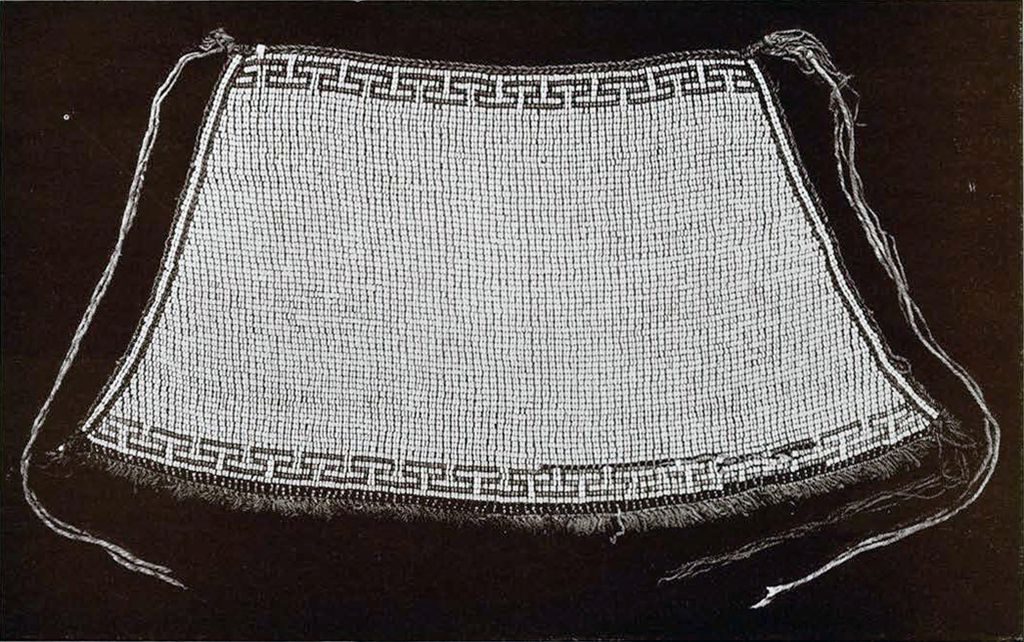
Museum Object Number: SA218
Image Number: 20783
Rough baskets for temporary use were made by intertwining the leaves of a folded palm frond, while carrying baskets were made of split bush-rope or palm fronds. The finest baskets were used by men for their trinkets and toilet articles, and these were usually decorated with a very realistic reproduction of some common animal. A part of the splits are stained black and these are used to form the outline of the animal. In Fig. 18 we have four baskets from four different tribes. In each case two animals are shown facing each other and are exactly alike. By referring to Fig. 27 it will be noted how similar these are to the original drawings. One difference is seen in the monkeys. The ones on the basket are of the big black variety, while the drawing shows the red howler with his big throat. The jaguar and the squirrel are very much alike, but their tails are sufficient to distinguish them. Compare also the bush dog with the squirrel and the jaguar. This dog has a short tail which never curls over his back.
Before the introduction of white man’s glass beads the women wore aprons made of a fringe of white or red cotton strings suspended in front from a narrow belt. When beads were secured their first and principal use was that of making aprons. A simlpe loom was first manufactured upon which the beads already strung were woven into small aprons, sometimes in solid color but more often different colors were introduced to represent animal figures or other designs common to basketry. As in basketry, so here the figures were either repeated to cover the whole apron or to form marginal designs. Figs. 19-23 show some examples with realistic figures, some with conventionalized ones and others with only marginal designs. Fig. 19 is a realistic scorpion; Fig. 20 is a double headed scorpion, while Fig. 21 is a combined lizard pattern. In all of these the apron is entirely covered with figures. Of the two remaining ones, Fig. 22 has wasp’s nest margins and Fig. 23 has palm leaf, small sloth and wasp’s nest designs. As evidence that these designs were taken from basketry, many of them show the cross-hatch peculiar to basketry faithfully copied. For the original drawings, see Fig. 27 as evidence.
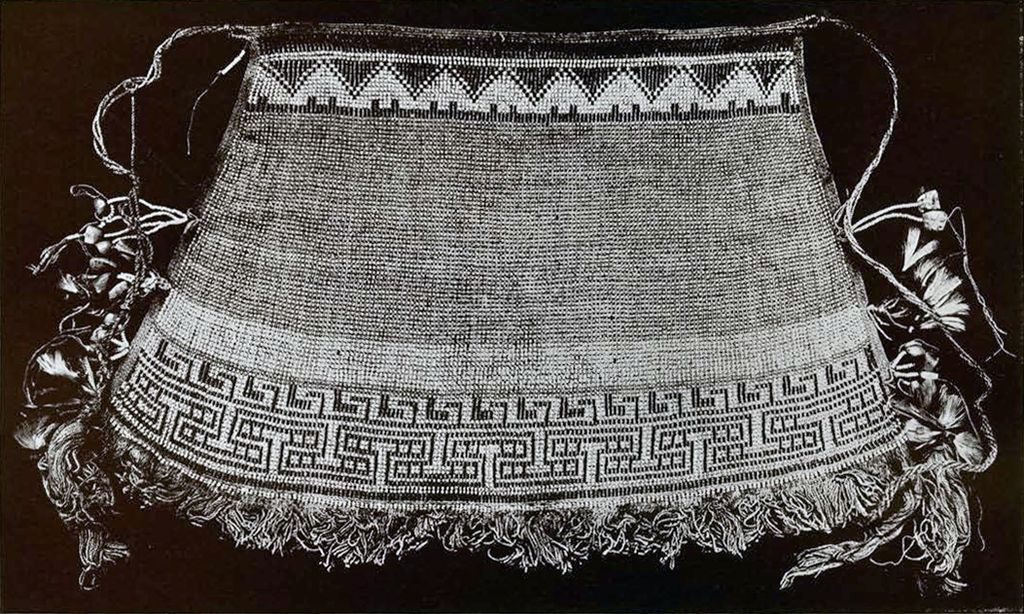
Museum Object Number: SA493
Image Number: 20777
The three clubs illustrated in Figs. 24-26 came from widely separated tribes. Fig. 24 has incised designs filled with white paint, at the end will be recognized the lizard with the fly’s eyes above and the fish tail at the top. The fly’s eyes might very well be developed into a continuous scroll, but no example of it was observed. The scorpion of Fig. 25 shows the remains of the cross-hatch in white dots between the lines. The central design of Fig. 26 is the upper part of the connected lizard design shown in Fig. 21. The wasp’s nest design is repeated around the border. All the designs of Fig. 26 are cross-hatched.
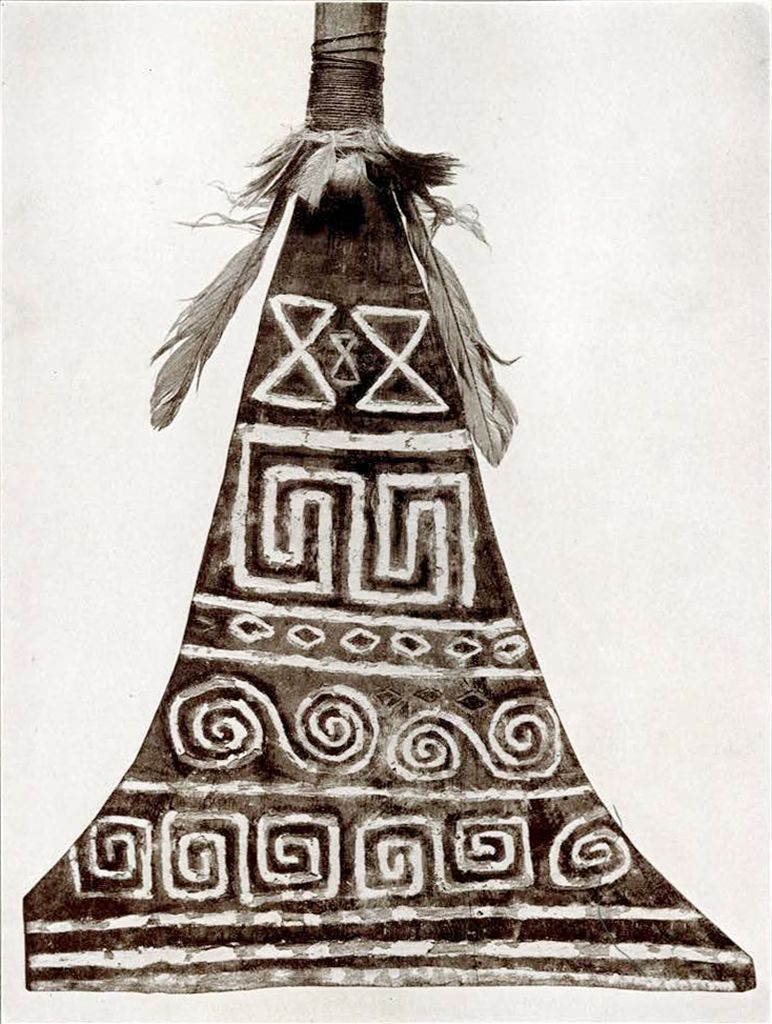
Museum Object Number: SA399A
Image Number: 20762
Fig. 27 is made up of exact copies of animal and plant figures drawn with a lead pencil by a Waiwai Indian. He had observed the author making rough drawings of objects about the village and his interest led to the loan of a book and pencil. After several hours of intermittent work and consultation with others he succeeded in making some thirty drawings and later furnished the names for them. These names correspond exactly with the names of the animals secured at other times. The name for the acouri is the same as that for the drawing of its characteristic mark. All the figures were recognized by other members of the village. The fact that those figures which any one can recognize are so faithfully drawn may be taken as evidence that the others also are correct. The figures are angular, though drawn with a pointed pencil, and in the presence of the real objects. This fact, together with the crosshatching, would indicate that he drew the objects from the memory of their appearance on basketry rather than from sight of them in life. His drawings show the difficulties that all savages experience in reproducing animal forms. The jaguar, squirrel, dog and monkey are shown in profile and easily distinguishable from each other, while the frog, alligator and turtle are shown from above. As it would be difficult to distinguish the forms of the other animals, some characteristic part or color was used instead; as fly’s eyes, ant’s jaws, peccary’s ribs, or the markings of the snake, acouri, small sloth; palm, bamboo, etc.
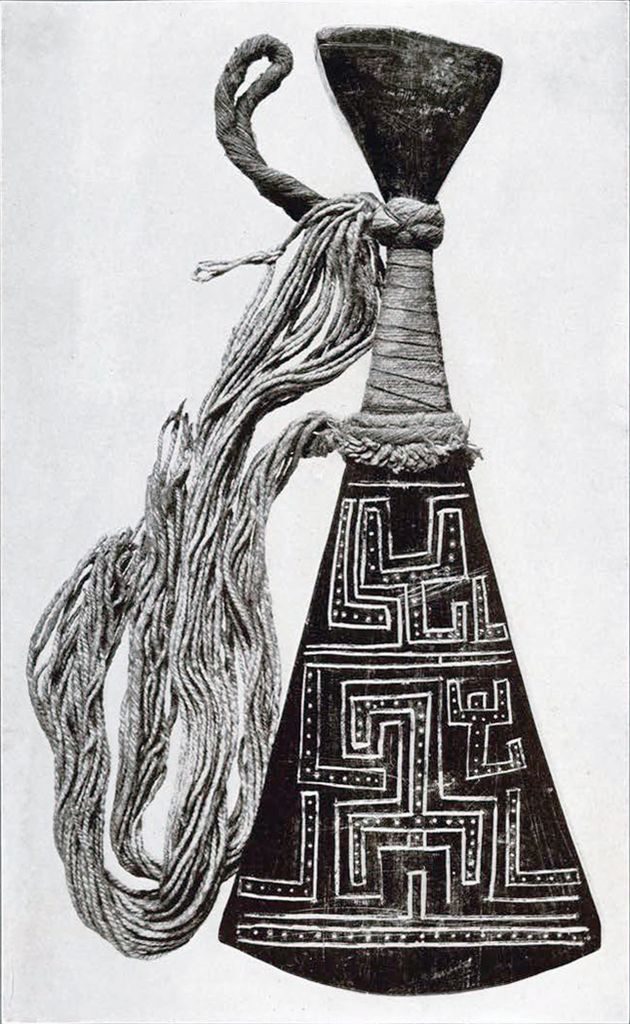
Museum Object Number: SA166
Image Number: 20760
Fig. 28 contains fifteen of the more common designs taken from the decoration of things in general use. No. 1 is the repeated one-half of a perfect sloth pattern, while No. 2 is the same thing with the sides merged into the border of the same color. No. 3 is the half of an acouri design. It is found on aprons, arm bands, whistles, clubs, etc. No. 4 is one-half of the wasp’s nest design. It has already been noted on aprons and clubs. No. 5 is a part of the bamboo figure taken from the margin of an apron. An interlocking lizard design is quite similar to this. No. 6 is one-half of a great sloth design painted on a wooden stool to fill an extra space. The same thing occurs on aprons. No. 7 is a sloth design taken from a flute. No. 8 is a modified bamboo figure. No. 9 from a knife handle shows an acouri on the right and a sloth on the left. No. 10 is the interlocking sloth design which occurs on aprons, stools, etc. No. 11 is the lizard and frequently occurs on bark armbands. The terraced design, No. 12, is not common. Bamboo designs are often modified, as in No. 13, or the same without the small squares in the corners, No. 14 was carved on a club and is interesting because it shows the cross-hatching of basketry. The last figure, composed of a combination of several designs, was copied from a painted design on the centre pole in a large Waiwai house. The original was forty inches high and seventeen inches around the pole. The connecting points are indicated.
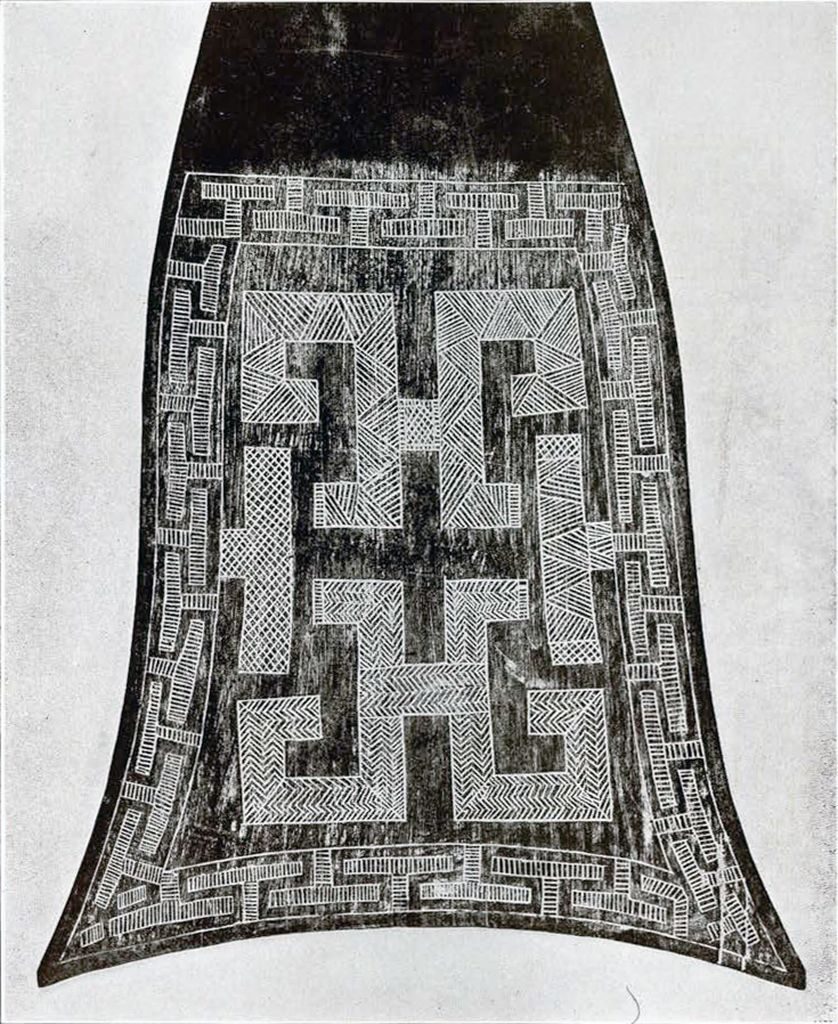
Museum Object Number: SA764
That all these designs had their origin in realism and that they were first used in basketry is shown by their history, as given by the natives, and as is proven by the cross-hatching of designs when used on beaded aprons, carved on wooden clubs and painted on armbands, clubs, cassava graters, etc.
I present this case as one of the most interesting reported from any people. The art is so simple and in such an early stage of development that all the steps in its evolution may be traced with certainty. Realism, conventionalism and symbolism are all present. Separate elements are used for purely artistic purposes, but the fundamental ideas underlying their significance are still remembered. Art has not become specialized in the hands of a few who excel in it, but each one adorns his own productions. Both men and women use the same realistic and conventional designs without distinction. There are no sacred animals represented, neither is there any evidence of fetishism or totemism. Animate figures therefore were introduced for purely decorative purposes. Conventionalism, symbolism and the simple geometric designs are here shown to develop directly from realistic forms.
W. C. F.

